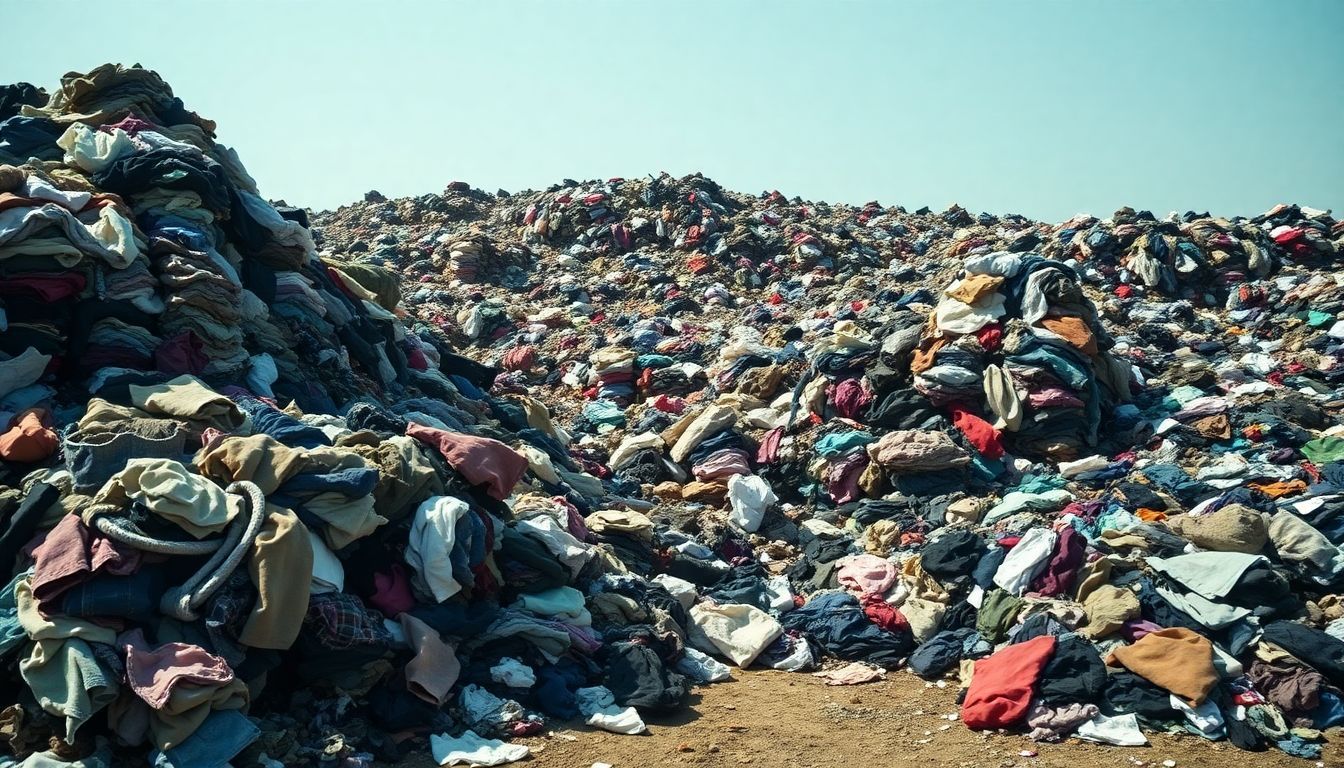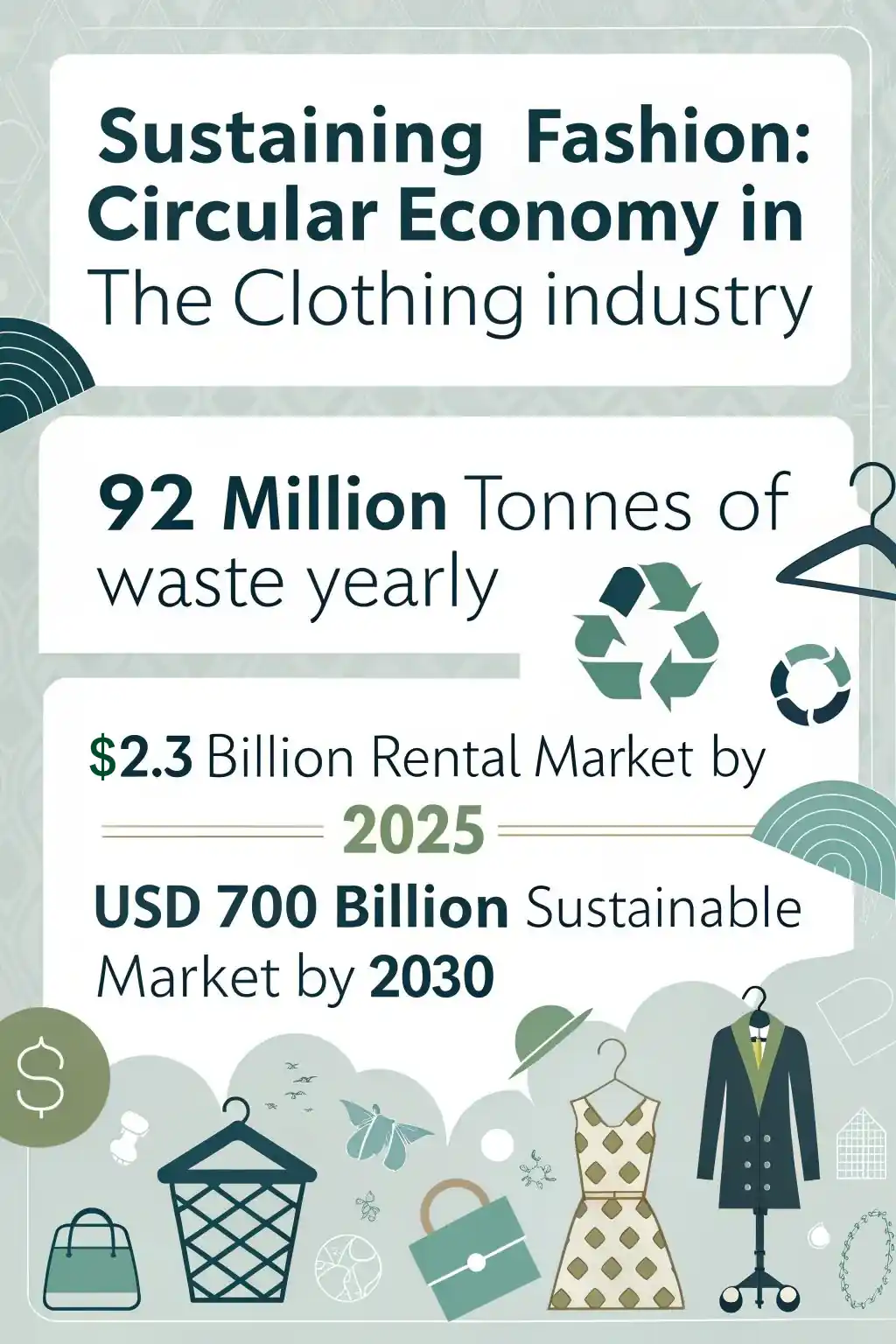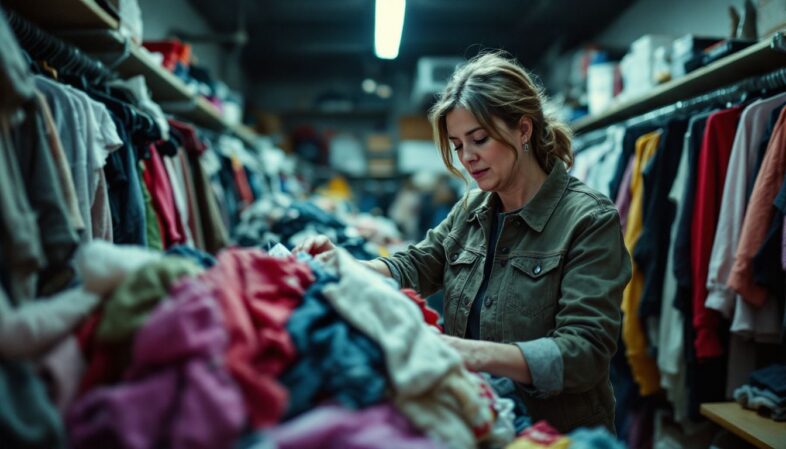Fast fashion fills our wardrobes, but most clothes end up in landfills within a year. Introducing the concept of the circular economy in fashion. It's the best hope for making our clothes sustainable.
The global clothing industry creates over 92 million tonnes of waste each year, making it one of Earth's biggest polluters.
A circular economy in the fashion industry offers a fresh path forward through reuse, repair, and recycling of garments. This shift could save billions in resources while cutting waste by 75%.
Learn These Topics About The Circular Economy In Fashion
- The fashion industry creates 92 million tonnes of waste yearly, with 85% of textiles ending up in landfills. Fast fashion brands push weekly collections, leading to massive waste and poor working conditions.
- Second-hand markets grew 21 times faster than regular retail in 2019. Major brands like Patagonia fix 50,000 clothing items yearly through repair services. The rental market will reach £2.3 billion by 2025, with companies like MUD Jeans leading the way at £7.50 monthly subscriptions.
- Digital platforms and smart recycling machines now sort fabrics by colour in seconds. Companies like Spiber create eco-friendly fibres from plants. These innovations help fashion brands turn old clothes into new materials without losing value.
- People wear clothes 40% less than they did ten years ago. Americans use their garments at just one-quarter of the global average. The fashion industry could eat up 26% of the carbon budget needed to keep global warming under 2°C by 2050.
- The circular fashion market is worth USD 73 billion globally. Brands like Eileen Fisher's Renew programme take back used clothes for resale. The sustainable fashion market should reach USD 700 billion by 2030.
Current Challenges in the Clothing Industry

The fashion industry faces a massive waste crisis, with 85% of textiles ending up in landfills each year. Fast fashion brands pump out new collections every week, pushing shoppers to buy more clothes than they need while workers struggle with poor wages and unsafe conditions.

Underutilisation of clothing
Modern shopping habits have created a massive waste problem in our wardrobes. People now wear clothes 40% less than they did a decade ago, with Americans using their garments at just one-quarter of the global average.
Fast fashion drives this trend, pushing consumers to buy more while wearing items less frequently.
This wasteful pattern costs the fashion sector dearly, with £380 billion worth of wearable clothes ending up in landfills each year. Many perfectly good garments sit unused in closets or get binned after just a few wears.
Retail managers must tackle this issue by promoting smarter buying habits and creating resale programmes. Fashion brands can boost profits by helping shoppers make better use of their existing clothes through repair services and style advice.
High environmental impact
Beyond unused clothes filling landfills, the fashion industry leaves a massive environmental footprint. The textile sector gobbles up 98 million tonnes of non-renewable resources each year.
Oil, fertilisers, and chemicals flow into clothing production at an alarming rate. Polyester, a popular synthetic fabric, makes up 52% of global fibre use. Its production spews greenhouse gases into our atmosphere.
The numbers paint a grim picture for our planet's future. Fashion's current path could eat up more than 26% of the carbon budget needed to keep global warming under 2°C by 2050. The recycling situation adds to this crisis.
Less than 1% of textiles worldwide get a second life as new products. Most clothes end up in landfills or incinerators, releasing harmful chemicals into our soil and air. I've seen firsthand how fast-fashion retailers push new collections weekly, speeding up this destructive cycle.
This rapid turnover forces constant production, draining natural resources and pumping more pollutants into our environment.
Unsustainable production practices
The fashion industry's current production methods harm our planet at an alarming rate. Each year, clothing makers use 98 million tonnes of non-renewable resources like oil and chemicals to create new garments.
Fast fashion companies push out massive amounts of cheap clothes through harmful manufacturing processes. These practices drain natural resources, pollute water systems, and release toxic chemicals into the environment.
Most clothing production relies on harmful synthetic materials and wasteful methods. The industry doubles its output every 15 years, creating more environmental damage. Many brands burn millions of tonnes of unsold clothes or send them to landfills.
This massive waste shows how broken the system is. The next section explores how circular economy principles can fix these issues in the fashion industry.
The Vision of a Circular Economy in Fashion
Fashion brands now aim to create clothes that stay in use longer through smart design and better materials. This shift marks a bold move away from the old ‘take-make-waste' model to a system where clothes get new life through reuse, repair, and recycling.

Prolonging the lifecycle of garments
Extending garment life stands as a key profit driver in circular fashion, now valued at USD 73 billion globally. Smart brands like Patagonia lead this shift by fixing 50,000 clothing items yearly through their repair services.
The focus on longer-lasting clothes creates new income streams through repair, resale, and rental options. Companies must rethink their approach to product design, using sturdy materials and classic styles that stay relevant beyond fast fashion trends.
Repair programmes bring solid business benefits, as shown by Eileen Fisher's successful Renew initiative. This programme takes back used clothes, fixes them, and resells them to eager customers.
Such models cut production costs while opening fresh revenue channels. Simple steps like adding spare buttons, using quality threads, and creating repair-friendly designs make clothes last longer.
These changes help brands tap into the growing market for sustainable fashion, predicted to reach USD 700 billion by 2030.
Designing with renewable materials
Renewable materials stand at the forefront of sustainable fashion design. Companies like Spiber lead the charge with plant-based alternatives that replace harmful synthetic fabrics.
These eco-friendly materials create a path to reduce waste and limit global warming. Smart designers now mix natural fibres with recycled content to make durable, earth-friendly clothing.
Fashion brands must embrace biodegradable and regenerative materials to stay competitive. Plant-based fabrics offer a solution to microplastic pollution from synthetic clothes. The shift to renewable materials needs proper waste management systems and circular business models.
Digital product passports help track these materials through their life cycle. More fashion houses now partner with sustainable sourcing experts to find the right mix of renewable materials for their collections.

Reducing waste through closed-loop systems
Renewable materials pave the way for closed-loop systems in fashion. These systems catch waste at every step of clothing production. The textile industry needs better ways to handle its waste problem.
Right now, less than 1% of textiles turn into new products globally. This shocking number shows how much we waste in fashion.
Closed-loop systems offer a practical solution to this waste crisis. They capture and reuse materials through mechanical, thermal, and chemical recycling methods. The EU's new Extended Producer Responsibility rules will force brands to recycle textiles and implementing that began in January 2025.
Many fashion companies now build recycling stations in their shops. They collect old clothes and turn them into new products. This system cuts down on landfill waste and saves raw materials.
Smart brands use digital tracking to monitor their waste and find ways to reuse it.
Circular Business Models in Fashion
Fashion brands now offer fresh ways to buy and use clothes through rental services, second-hand markets, and repair shops – want to know more about these money-saving options that help our planet?

Rental and subscription services
Rental and subscription services shake up the traditional retail model. These services create fresh revenue streams while cutting down on waste.
- MUD Jeans leads the denim rental market with their monthly subscription plan at £7.50 per pair. Customers can swap their jeans for a new style after 12 months.
- Vigga's baby wear subscription tackles the rapid growth issue of children's clothing. Parents receive size-appropriate clothing bundles every 2-3 months, saving up to 70% compared to buying new items.
- Rent the Runway serves over 11 million members with designer clothing rentals. Their success shows strong market demand for temporary ownership models.
- Monthly clothing boxes from companies like Stitch Fix use AI to personalise selections. This reduces returns and improves customer satisfaction rates by 40%.
- The clothing rental market will reach £2.3 billion by 2025. More brands now offer subscription options to meet growing consumer interest.
- Subscription services cut textile waste by 60% through repeated use of each garment. One rented dress replaces 8-10 purchased items.
- Digital platforms make rental services more accessible. Mobile apps now handle 75% of rental transactions.
- Major retailers like H&M and Zara test rental programmes in key markets. Their data shows 85% customer retention in subscription models.
Resale and second-hand markets offer another path to sustainable fashion retail.
Resale and second-hand markets
Second-hand fashion markets have changed the game in retail clothing. These markets grew 21 times faster than regular retail in 2019, showing a massive shift in shopping habits.
- Major fashion brands now embrace resale platforms as their new revenue stream. Stella McCartney's partnership with The Real Real proves how luxury brands can profit from circular fashion.
- Digital platforms make buying and selling used clothes easier than ever. Apps and websites connect sellers directly to buyers, cutting out the middle person and making prices better for everyone.
- Quality checks on second-hand items boost shopper trust. Professional authentication services spot fake items and grade clothing condition, making shoppers feel safe about their purchases.
- Resale markets help brands reach new customers at lower prices. Reformation's team-up with ThredUp lets shoppers try premium brands without paying full price.
- Second-hand shopping cuts down on textile waste in landfills. Each reused item saves water and reduces carbon emissions from making new clothes.
- Social media drives growth in second-hand fashion sales. Influencers show how to style pre-loved pieces, making second-hand shopping cool and trendy.
- Pop-up second-hand markets create buzz around sustainable shopping. These events turn shopping used clothes into fun social gatherings.
- Second-hand markets create jobs in sorting, cleaning, and selling clothes. This growth helps local economies while supporting sustainable fashion.
- Price tracking tools help sellers set fair rates for used items. These tools check past sales data to suggest the best selling prices.
- Authentication services protect buyers from counterfeit products. Expert teams check details like stitching and labels to spot real from fake items.
Repair and refurbishment initiatives
Repair services have become a game-changer in sustainable fashion. Major brands now lead the charge in fixing clothes instead of pushing new sales.
- Patagonia stands as a repair champion, fixing 50,000 clothing items each year through their repair centres. Their team teaches customers basic mending skills through free workshops.
- Eileen Fisher's Renew programme takes back used clothes, cleans them, and repairs any damage. The brand resells these items at lower prices, creating a perfect circle of use.
- In-store repair stations pop up at Jack Wolfskin shops across Europe. Staff fix zippers, patch holes, and replace buttons whilst customers wait.
- Bergans offers repair kits with their products. These kits contain matching threads, fabric patches, and simple tools for quick fixes at home.
- Houdini sports shops train their staff in basic repairs. Customers bring in torn jackets or worn trousers for same-day fixes.
- Mobile repair vans travel to different cities, bringing repair services to people's doorsteps. These vans carry sewing machines, spare parts, and skilled workers.
- Fashion schools now teach repair skills as part of their core training. New designers learn how to create clothes that last longer and fix easily.
- Online repair guides help people fix clothes at home. Clear videos show step-by-step instructions for common repairs.
- Community repair cafes bring people together to fix clothes. Expert sewers volunteer their time to teach others and help with tricky repairs.
- Repair tracking apps help brands measure their impact. These apps count fixed items and show how many clothes stay out of landfills.
Innovations Driving Circular Fashion
Tech breakthroughs in fashion now make circular shopping a daily reality. Digital platforms and smart recycling machines have changed how we buy, sell, and reuse clothes, making sustainable fashion more accessible to everyone.
Digital platforms for resale and rental
Digital fashion platforms have changed how we buy and sell clothes. ThredUP leads the pack in online resale, making it simple for fashion brands to join the circular economy. These platforms use smart tech to match buyers with sellers, track inventory, and handle payments smoothly.
Blockchain technology helps prove item authenticity and tracks each piece's journey through the supply chain.
Tesco's F&F clothing line shows how digital product passports work in real life. Each garment gets a unique digital ID that stores its history, materials, and care instructions. Hire Street brings rental fashion to everyone's doorstep with easy-to-use apps and quick delivery services.
The rise of these platforms points to exciting advances in textile recycling technologies, which will shape the future of sustainable fashion.
Advancements in textile recycling technologies
Textile recycling has grown smarter through new mechanical, thermal, and chemical methods. Modern machines can now sort fabrics by colour and material type in seconds. Chemical recycling breaks down polyester into its basic building blocks, creating new fibres that match virgin quality.
These systems help fashion brands turn old clothes into fresh materials without losing value. Companies like Spiber lead the charge in creating strong, eco-friendly fibres from plant sources.
Their innovations cut the need for new raw materials and slash waste.
The latest recycling tech brings hope to our waste problem in fashion. Smart sorting machines use artificial intelligence to process tonnes of textiles each day. New chemical processes can separate blended fabrics – a task that stumped scientists for years. And don't say it cannot be done because construction waste recycling came from nowhere 15 years ago in the UK and now over 90% is recycled!
These breakthroughs mean more clothes stay out of landfills. The next big step focuses on making these technologies work at larger scales. Moving forward, let's explore how consumers play a vital role in supporting circular fashion through their daily choices.
Use of biodegradable and regenerative materials
Moving beyond recycling tech, fashion brands now use nature-friendly materials for a greener future. Plant-based fabrics from companies like Spiber lead this shift in sustainable clothing production.
These materials break down naturally at the end of their life cycle, leaving no harmful waste behind.
Biodegradable materials provide a smart solution to fashion's waste problem. Natural fibres like hemp, organic cotton, and mushroom leather create clothes that return safely to the earth.
Many fashion brands combine these eco-friendly materials with regenerative farming methods. This approach helps restore soil health and captures carbon from the air. The outcome? Clothes that look good and help heal our planet.
The Role of Consumers in Supporting Circular Fashion
Your shopping choices shape the future of fashion. Small changes in your buying habits, like picking second-hand clothes or renting outfits, create a big impact on reducing fashion waste.
Adopting sustainable purchasing habits
Sustainable shopping habits create lasting change in the fashion industry. Recent data shows 75% of shoppers care about sustainability, yet only 34% make green purchases.
- Shop with a clear plan to avoid impulse buys. Make a list of needed items and stick to it. This cuts down waste and saves money.
- Calculate cost-per-wear before buying clothes. A £100 jacket worn 100 times costs £1 per wear, making it more valuable than a £20 top worn twice.
- Pick natural fibres that break down safely. Cotton, hemp, and linen reduce microplastic pollution in water systems.
- Read product labels for recycled content. Many brands now use post-consumer materials in their clothing lines.
- Support second-hand markets through resale platforms. These extend garment life and reduce landfill waste.
- Choose timeless styles over fast-fashion trends. Classic pieces stay in style longer and need less frequent replacement.
- Buy from brands with clear sustainability goals. Look for published environmental reports and waste reduction targets.
- Check garment construction quality at seams and hems. Strong stitching means longer-lasting clothes.
- Select clothes that match existing wardrobe items. This creates more outfit combinations with fewer pieces.
- Learn basic repair skills for clothing maintenance. Simple fixes like button replacement extend garment life significantly.
- Invest in quality over quantity. Better-made items last longer and need less frequent replacement.
- Choose local brands to reduce transport emissions. This supports regional economies and cuts carbon footprint.
Caring for and extending the life of garments
Smart buying habits lead straight into proper garment care. Your clothes deserve the same attention you give to picking them out, and here's how to make them last longer.
- Wash clothes at lower temperatures (30°C) to cut energy use and keep fibres strong. Cold water stops colours from running and maintains fabric shape.
- Turn garments inside out before washing to protect prints and reduce wear on the outer surface. This method shields decorative elements from friction.
- Store clothes properly with wooden hangers for suits and knits on flat surfaces. Good storage stops stretching and keeps shapes intact.
- Fix small issues right away – loose buttons, tiny holes, or fallen hems need quick attention. Small repairs prevent bigger problems later.
- Air dry clothes whenever possible instead of using tumble dryers. Natural drying reduces energy use and protects fabric fibres.
- Read care labels carefully and follow their instructions exactly. Each fabric type needs specific care to stay in top shape.
- Clean clothes only when truly needed, not after every wear. Over-washing can weaken fibres and fade colours faster.
- Use garment bags for delicate items during washing. These bags guard against snags and tears from zippers or hooks.
- Steam clothes instead of ironing when possible. Steam refreshes fabrics with less wear and tear than traditional ironing.
- Keep shoes clean and use shoe trees to maintain their shape. Good shoe care extends their life and keeps them looking smart.
- Remove stains quickly with the right cleaning method for each type. Fast action stops stains from setting permanently.
- Store seasonal clothes in breathable containers away from direct light. Proper storage guards against moths, dust, and fading.
Conclusion
The clothing industry stands at a turning point. Circular fashion offers a clear path forward through smart recycling, resale markets, and rental services. Fashion brands must embrace these changes to cut waste and protect our planet.
Shoppers play a vital role too – by choosing eco-friendly clothes and making them last longer. Together, we can build a fashion system that works for both people and the environment.
FAQs About The Circular Economy In Fashion
1. What is circular fashion economy?
Circular fashion economy means making clothes that last longer through reusing, upcycling, and recycling. It fights overconsumption and waste in the fashion industry. Think of it as giving your clothes many lives instead of just one!
2. How does circular fashion help fight climate change?
Circular fashion cuts down scope 1 and scope 3 emissions by using recycled materials and reducing waste. It saves nonrenewable resources and helps lower microplastics in our oceans. This makes fashion more eco-friendly.
3. What are the cost benefits of sustainable fashion?
Sustainable fashion brings savings through smart design and reuse. While eco-design might cost more at first, it leads to long-term gains. Plus, secondhand shopping saves money and helps the planet!
4. How can fashion brands avoid greenwashing?
Brands need clear sustainability reporting and honest ESG scores. They should follow the circular economy action plan and show real sustainable practices. Good sustainability means walking the talk!
5. What role do consumers play in circular fashion?
Consumer behaviour drives change in fashion. By choosing sustainable products, supporting slow fashion, and buying secondhand, shoppers help build a circular industry. Small choices make big waves!
6. How can fashion businesses become more sustainable?
Fashion businesses can focus on sustainable development through adopting the Circular Economy in fashion as follows:
– Using renewables
– Building recycling infrastructure
– Following extended producer responsibility (EPR)
– Working with sustainable finance partners
– Making products that last longer
The Evolution of Food Waste Processing Technologies: From Wet to Waterless Biodigesters
Read on for the latest news on the development of wet and waterless biodigesters as a means of processing Food Waste. As food waste management becomes an increasingly pressing issue for environmental sustainability, the evolution of waste processing technologies has been a game-changer in how we handle organic material. For decades, the food waste processing […]
The Future of UK Food Waste Management – Simpler Collections and Tougher Regulation
The future of UK food waste management will be a big push toward higher recycling rates through simpler collection and far greater consistency across the nations, helping citizens understand how to be green and recycle more organic waste. As the UK continues to advance its environmental goals, recently announced government policies aimed at simplifying waste […]
The Ultimate Guide To Recycling Plasterboard: How To Dispose Of Plasterboard Waste Properly
Plasterboard is a popular building material used in homes and offices. It's light, strong, and easy to work with. But when it turns into waste, we can't just throw it away like old food wrappers. Rules say plasterboard must not mix with other trash because it can harm the environment. Luckily, clean plasterboard can go […]
Unfashionable Talk About Landfills
Get ready for unfashionable talk about landfills! Let's talk rubbish—literally. You might not think about landfills much unless the smell drifts your way on a windy day or you're tossing out the garbage. But these dumping grounds are more than just piles of junk; they're a snapshot of our consumer habits and a challenge we need to tackle. Landfill […]









